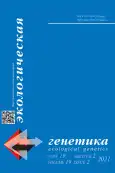About some genetic terms, their content and education
- Authors: Daev E.V.1,2
-
Affiliations:
- Saint Petersburg State University
- Pavlov Institute of Physiology of the Russian Academy of Sciences
- Issue: Vol 19, No 2 (2021)
- Pages: 181-192
- Section: Opinions, discussions
- URL: https://journals.rcsi.science/ecolgenet/article/view/34777
- DOI: https://doi.org/10.17816/ecogen34777
- ID: 34777
Cite item
Abstract
Ambiguity of genetic terms usage leads to their misinterpretation and learning difficulties. The content of some concepts is analyzed as well as haziness and mistakes in usage of corresponding terms such as gene, allele, genotype, phenotype, polymorphism, heritability, variability and few others. Limitations of the model dividing separately impact of the environment and genotype in a feature formation are explored. The interaction of the environment and hereditary material is suggested as basic factor of genetic and phonetic variability.
Full Text
##article.viewOnOriginalSite##About the authors
Eugene V. Daev
Saint Petersburg State University; Pavlov Institute of Physiology of the Russian Academy of Sciences
Author for correspondence.
Email: mouse_gene@mail.ru
ORCID iD: 0000-0003-2036-6790
SPIN-code: 8926-6034
PhD, Dr. Sci. (Biol.)
Russian Federation, 7–9 University embankment, Saint Petersburg, 199032References
- Kucher AN, Babushkina NP, Kulish EV, et al. Characteristic of the genetic variability of four polymorphic variants (rs2069705, rs17880053, rs11126176, and rs804271) in representative samples of indigenous and arrived populations of Siberia. Russian Journal of Genetics. 2015;51(8)946–952. (In Russ.) doi: 10.7868/S0016675815070073
- Valova YV, Kutlina TG, Mukhammadiyeva GF, et al. The role of polymorphic variants of cytokine family genes in developing bronchial asthma in the republic of Bashkortostan. Meditsina truda i ehkologiya cheloveka. 2017;3(11):83–86. (In Russ.)
- Ajala F, Kajger Dzh. Sovremennaja genetika. Vol. 2. Moscow: Mir; 1988.
- Speicher MR, Antonarakis SE, Motulsky AG. Genetika cheloveka po Fogelju i Motulski. Problemy i podhody. Saint Petersburg: Izd-vo N-L; 2013. 1056 p.
- Hryhorowicz S, Ziemnicka K, Kaczmarek-Ryś M, Hoppe-Gołębiewska J, et al. CCND1 gene polymorphic variants in patients with differentiated thyroid carcinoma. Oncol Lett. 2015;9(1):442–448. doi: 10.3892/ol.2014.2617
- Ong’echa JM, Raballah EO, Kempaiah PM, et al. Polymorphic variability in the 3’ untranslated region (UTR) of IL12B is associated with susceptibility to severe anaemia in Kenyan children with acute Plasmodium falciparum malaria. BMC Genet. 2011;12:69. doi: 10.1186/1471-2156-12-69
- Ponomareva IN, Kornilova OA, Loshhilina TE, Izhevskij PV. Biologija. 11-j klass. Bazovyj uroven’. 3rd ed., Moscow: Ientana-Graf; 2013.
- Galton F. The history of twins, as a criterion of the relative powers of nature and nurture. Fraser’s Mag. 1875;12:566–576.
- Siemens H. Die Zwillingspathologie. Berlin: Springer-Verlag; 1924.
- Siemens HW. The diagnosis of identity in twins. The Journal of Heredity. 1927;18(5):201–209. doi: 10.1093/oxfordjournals.jhered.a102846
- Holzinger, KJ. The relative effects of nature and nurture influences on twin differences. J Educ Psychol. 1929;20(4):241–248. doi: 10.1037/h0072484
- Hirsch NDM. Twins: Heredity and Environment. Cambridge MA: Harvard University Press; 1930. 158 p.
- Malyh SB, Egorova MS, Meshkova TA. Osnovy psihogenetiki. Moscow: Jepidavr; 1998. 744 p.
- Aleksandrov A.A. Psihogenetika. Saint Petersburg: Piter; 2004. 192 p.
- Tihodeev ON. Osnovy psihogenetiki. Moscow: Izd. Centr Akademija; 2011. 320 p.
- Rende RD, Plomin R, Vandenberg SG. Who Discovered the Twin Method? Behavior Genetics.1990;20(2):277–285. doi: 10.1007/BF01067795
- Plomin R, DeFries JC, Knopik VS, Niderhiser JM. Top 10 replicated findings from behavioral genetics. Perspectives on Psychological Sciences. 2016;11(1):3–23. doi: 10.1177/1745691615617439
- Inge-Vechtomov SG. Genetika s osnovami selekcii. Moscow: Vysshaja shkola; 1989. 591 p
- Inge-Vechtomov SG. Genetika s osnovami selekcii. Saint Petersburg: N-L; 2015. 720 p.
- Fogel’ F, Motul’ski A. Genetika cheloveka. Vol. 1. Moscow: Mir; 1989.
- Fogel’ F, Motul’ski A. Genetika cheloveka. Vol. 3. Moscow: Mir; 1990.
- Poulsen P, Kyvik KO, Vaag A, Beck-Nielsen H. Heritability of type II (non-insulin-dependent) diabetes mellitus and abnormal glucose tolerance – a population-based twin study. Diabetologia. 1999;42(2):139–145. doi: 10.1007/s001250051131
- Freed D, Stevens EL, Pevsner J. Somatic Mosaicism in the Human Genome. Genes. 2014;5(4):1064–1094. doi: 10.3390/genes5041064
- Daughtry BL, Chavez SL. Chromosomal instability in mammalian pre-implantation embryos: potential causes, detection methods, and clinical consequences. Cell Tissue Res. 2016;363(1):201–225. doi: 10.1007/s00441-015-2305-6
- Johannsen W. The Genotype Conception of Heredity. The American Naturalist. 1911;45(531):129–159.
- Dawkins R. The Extended Phenotype. NY: Oxford University Press; 1982. 295 p.
- Shhipkov VP, Krivosheina GN. Obshhaja i medicinskaja genetika. Moscow: Academia; 2003. 256 p.
- DiLalla LF. Developmental Neuropsychology: behavioral genetic perspective. Developmental Neuropsychology. 1998;14(1):1–7. doi: 10.1080/87565649809540697
- Lewkowicz D. The Biological Implausibility of the Nature-Nurture Dichotomy & What It Means for the Study of Infancy. Infancy. 2011;16(4):331–367. doi: 10.1111/j.1532-7078.2011.00079.x
- Galstjan A.G. Rol’ nasledstvennosti i sredy v formirovanii zdorov’ja cheloveka. Sovremennye problemy nauki i obrazovanija. 2016;(4). Available from: http://www.science-education.ru/ru/article/view?id=25084
- Smith C. Concordance in Twins: Methods and Interpretation. Am J Hum Genet. 1974;26(4):454–466.
- Bueno D. Genetics and Learning: How the Genes Influence Educational Attainment. Front Psychol. 2019;10:1622. doi: 10.3389/fpsyg.2019.01622
- Tikhodeyev ON. Variability and its types: the differential approach. Proceedings of the Zoological Institute of the Russian Academy of Sciences. 2018;322(2):185–201.
- Merriam-Webster.com [Internet] Definition of heritability. Available from: https://www.merriam-webster.com/dictionary/heritability [cited 2021 April 29].
- Britannica.com [Internet] Encyclopædia Britannica. Heritability (Aricle). Available from: https://www.britannica.com/science/heritability [cited 2021 April 29].
- Barlow FK. Nature vs. nurture is nonsense: On the necessity of an integrated genetic, social, developmental, and personality psychology. Aust J Psychol. 2019;71(1)68–79. doi: 10.1111/ajpy.12240
- Ravich-Shcherbo IV, Marjutina TM, Grigorenko EL. Psihogenetika. M.: Aspekt Press; 2000. 447 p.
- Maxson LR, Daugherty CH. Genetics. A Human Perspective. 2nd ed. Dubuque, Iowa: Wm. C. Brown Publ; 1988. P. 1–416.
- Griffiths AJF. An Introduction to Genetic Analysis. 9th edition. W.H. Freeman & Company; 2007. 707 p.
- Inge-Vechtomov SG. Jazyk uchenogo i nacional’naja ideja. In: Problemy dejatel’nosti uchenogo i nauchnyh kollektivov. Vol. 26. Saint Petersburg: Izd-vo Politehnicheskogo universiteta; 2011. P. 197–205.
- Thörne K, Gericke NM, Hagberg M. Linguistic Challenges in Mendelian Genetics: Teachers’ Talk in Action. Science Education. 2013;97(5):695–722. doi: 10.1002/sce.21075
Supplementary files







